Finding Your Perfect Fit: Circus Costumes with Duo Rose and Gena Cristiani
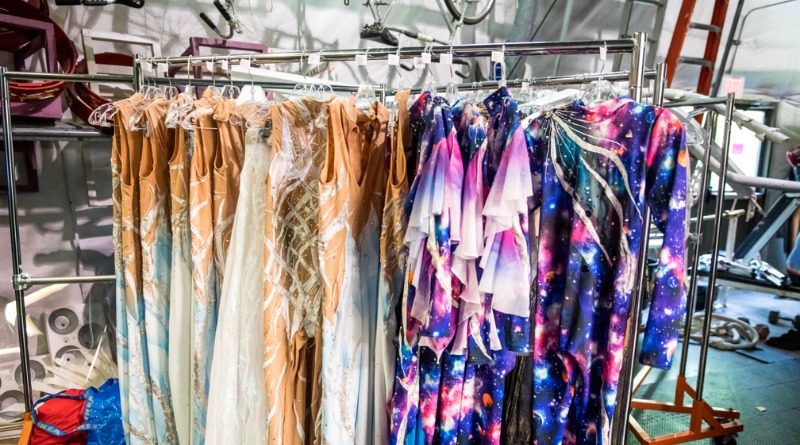
Seeking your perfect circus costume? A great one helps you sell yourself and your act to talent seekers. The best way to begin your search is to learn what fits. Expanding on my segment in last November’s Press Pass with the Editor podcast, I pull in costume design experts to teach you all the ins and outs of circus costuming: finding them and figuring what’s right for your act, body, style, or budget.
Finding Your Costumes 101

Having a high-quality costume you can wear for gigs is a worthwhile investment in your career. That said, up-and-coming performers might not know where to begin their search. To that end, you can design your own costume, or buy one pre-made from a specialty seller. Etsy is one good place to try, or websites that sell dance apparel. CircusBoss also has a section of gently used costumes on their website, though be sure to check the measurements carefully: they’re sold as-is. And this adviceis about as much help as you’ll get from Google-searching for the phrase “circus costume.”
For more expert advice on costuming, I spoke with costume and prop designers Samuel Sion and Sylvia Friedman from Big Apple Circus. As well as their design work, they’re both performers in their own right as the trapeze act Duo Rose.
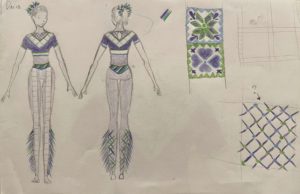
Sylvia says she finds the design process to be rewarding as a performer: “In addition to being able to showcase another of my artistic passions, I enjoy being able to build trick-specific solutions into our costumes, to really optimize how they function in a show. My costume, for instance, has a neckpiece which anchors to my hair and functions both to improve Sam’s grip for our neck hang, and to keep rosin off the back of my neck.”
As mentioned, costumes are a worthwhile investment for career performers— but exactly how much money you’ll have to invest in one can vary heavily. According to Sam and Sylvia, different kinds of gigs and venues might require separate costumes, and“what might be perfectly appropriate for one market may not fit at all in another.” Custom costumes will cost more than ones bought off-the-rack. You’ll also have to pay for the designer’s time and any time-intensive details. Based on her own commission work, Sylvia suggests a custom-made costume “would cost about a week’s pay for a longer run, or one to two galas.”
If you want to design your own costume, set out to make something you’re comfortable with. As Sylvia puts it, “Starting from a function-first perspective is never inappropriate.” You also want to avoid possible wardrobe malfunctions on stage: “Durability is important, and it absolutely pays off to make sure your closures will not open if you don’t want them to,” says Sylvia.
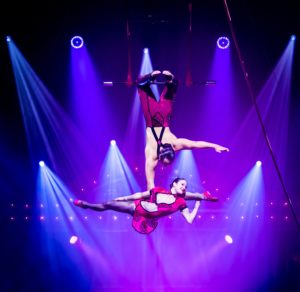
Another thing to note: online search results for “professional circus costumes” skew toward Halloween costumes, or acrobatic apparel. If you’re an acrobat or physical artist, that’s good news. Artists from other disciplines may feel at a loss for resources.
Fortunately, all kinds of performing artists can still find inspiration with a few quick tricks. Find promotional pictures for other shows that showcase performers from your discipline. Sam and Sylvia advise, “For artists wondering what costuming would be appropriate for a market they’re hoping to get into, they will be able to gauge by what other artists are wearing and determine what types of details are expected. You of course don’t want to copy anyone’s existing costume, but you want something that you can imagine standing next to these other performers in. As for where to buy professional costumes, looking for costume credits can help, or even just asking people whose costumes you like where they got them.”
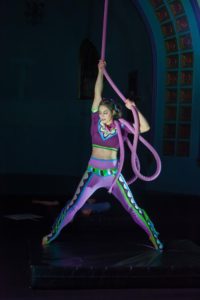
Design Behind the Scenes
Maybe you already have a clear vision of your dream costume, but you’re not sure how, or if, that vision can best be put to fabric… or how to approach the designer you want to commission it from. Perhaps you want to try your own hand at costume-making. To see how designers do their work and make costuming decisions from the more artistic side, I turned to Gena Cristiani.
As well as being a juggler, Gena runs her own costume design business. She has outfitted performers for big events and shows (including the inaugural run of Omnium Circus!), as well as artists from all around the world.
Clients reach out to Gina through her business’ Facebook page; she checks their profiles and asks them questions to learn more about the specifics of their act. Once she has what she needs from her client, she has them send her a full-body photograph. Using it as a base, she’ll plan out her design and digitally sketch it onto the client’s body before sending the image back to them for their input.
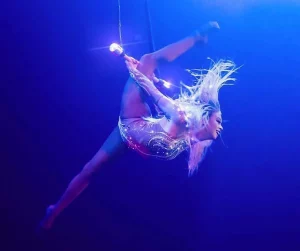
“As a designer, one of my priorities has been to suit my clients’ needs in every way possible,” says Gena. She honors special requests, such as for sleeveless costumes. She chooses her materials very carefully, opting for fabrics that maximize the performer’s comfort– “I don’t want them to have to think about anything but their act when they’re onstage,” she explains– and the right colors for their skin tone: “When you’re making a nude illusion costume, say, it can be hard to find the right shade of fabric versus the ones generally labeled as ‘nude’.” If she can’t find any premade material to match their skin, she’ll color-dye the fabric herself. Since Gena ships costumes to clients worldwide, they’re seldom able to sit down and have a formal fitting session, so she works largely from the photos and measurements that they provide. “Even though– knock on wood– I seem to have it down pretty well, ensuring fit is always a bit nerve-racking,” she admits. (And here I’ll repeat: it never hurts to double-check your measurements before you send them.)
Thinking about costumes as your designer would can not only help them to do a good job; it can also help you to grow as a performer. As Gena describes it, performance and designing work together in tandem. “For me, designing stems from being born into the circus world,” she says. “I’d always been around art growing up. I drew a lot as a kid: it went from pencil on paper to using crayons, markers, and paint, and then my canvas changed from paper into fabrics.” Being a performer herself gives her an edge in knowing what types of costumes work for different acts. “Ground performers— like jugglers, for example— can wear fun skirts that would get caught on an aerialist’s equipment. Aerialists go for form-fitting bodysuits. No matter what kind of act you do, you don’t want to have any fabric getting in the way of your movement.”
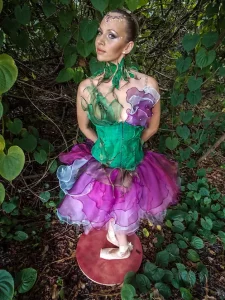
So long as you take the pragmatics of the design into account, there’s almost no limit to the effects you can achieve through costuming. Honor a high-class venue with a formal costume, or cater to a themed performance or event. For instance, at a botany-themed event, a New York City museum commissioned Gena to make costumes for three performers, patterned on a lily, an orchid, and a rose. “When I saw the measurements, I realized the rose was for my sister,” Gena laughs. She turned her into a red rose, crafting a bodysuit with hand-painted flowers and a removable skirt, with a rosebud on the high heels for good measure.
You can take your costume creativity even further with tricks that border on the outright magical. Gena describes watching from the stands as an equestrian performer shed her huge, black cloak mid-performance to reveal a phoenix costume underneath. (Think Katniss Everdeen turning into the Mockingjay.) Gena had made the woman’s phoenix wings herself, attaching them to a vest. “The image of that woman on her horse, spreading out her wings, has stuck with me,” she says.
The right performance costume is transformative: it turns an already great act (yours!) into something unforgettable.
Image credits to Samuel Sion and Gena Cristiani. Big Apple Circus photos credited to Joanna Connelly, Lukas Pitsch and Sandy Morris. Main image is courtesy of Betty Butler and Gena Cristiani.
Editor's Note: At StageLync, an international platform for the performing arts, we celebrate the diversity of our writers' backgrounds. We recognize and support their choice to use either American or British English in their articles, respecting their individual preferences and origins. This policy allows us to embrace a wide range of linguistic expressions, enriching our content and reflecting the global nature of our community.
🎧 Join us on the StageLync Podcast for inspiring stories from the world of performing arts! Tune in to hear from the creative minds who bring magic to life, both onstage and behind the scenes. 🎙️ 👉 Listen now!
